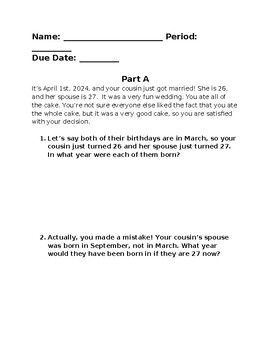Problem of the Month - Family Tree Expressions
The Masked Mathematician
3 Followers
Grade Levels
6th - 9th
Subjects
Resource Type
Standards
CCSS6.EE.A.2
CCSS6.EE.A.2c
CCSS7.EE.B.4
CCSSMP2
CCSSMP8
Formats Included
- Word Document File
Pages
10 pages
The Masked Mathematician
3 Followers
Also included in
- Problem of the Month: Through fun, quirky, challenging word problems, students will apply their knowledge to a variety of math topics. The level A problems introduce the theme and basic mathematics, and the level E problems will challenge even advanced older students. This is designed for middle schPrice $3.00Original Price $4.50Save $1.50
Description
Problem of the Month: Through fun, quirky, challenging word problems, students will apply their knowledge of expressions to finding ages of family members an creating a family tree. Students will tackle a series of problems with increasing difficulty. The level A problems involve finding the ages of their cousins, and the level E problems involve using a expressions/formulas to create a detailed family tree with birthdays and ages. This is designed for middle schoolers - sixth graders will be able to engage with the problems, and even eighth graders will be challenged by the end.
Includes:
- Packet with 5 levels of problems.
- Fully editable
- Answer key
Total Pages
10 pages
Answer Key
Included
Teaching Duration
N/A
Report this resource to TPT
Reported resources will be reviewed by our team. Report this resource to let us know if this resource violates TPT’s content guidelines.
Standards
to see state-specific standards (only available in the US).
CCSS6.EE.A.2
Write, read, and evaluate expressions in which letters stand for numbers.
CCSS6.EE.A.2c
Evaluate expressions at specific values of their variables. Include expressions that arise from formulas used in real-world problems. Perform arithmetic operations, including those involving whole-number exponents, in the conventional order when there are no parentheses to specify a particular order (Order of Operations). For example, use the formulas V = s³ and A = 6 s² to find the volume and surface area of a cube with sides of length s = 1/2.
CCSS7.EE.B.4
Use variables to represent quantities in a real-world or mathematical problem, and construct simple equations and inequalities to solve problems by reasoning about the quantities.
CCSSMP2
Reason abstractly and quantitatively. Mathematically proficient students make sense of quantities and their relationships in problem situations. They bring two complementary abilities to bear on problems involving quantitative relationships: the ability to decontextualize-to abstract a given situation and represent it symbolically and manipulate the representing symbols as if they have a life of their own, without necessarily attending to their referents-and the ability to contextualize, to pause as needed during the manipulation process in order to probe into the referents for the symbols involved. Quantitative reasoning entails habits of creating a coherent representation of the problem at hand; considering the units involved; attending to the meaning of quantities, not just how to compute them; and knowing and flexibly using different properties of operations and objects.
CCSSMP8
Look for and express regularity in repeated reasoning. Mathematically proficient students notice if calculations are repeated, and look both for general methods and for shortcuts. Upper elementary students might notice when dividing 25 by 11 that they are repeating the same calculations over and over again, and conclude they have a repeating decimal. By paying attention to the calculation of slope as they repeatedly check whether points are on the line through (1, 2) with slope 3, middle school students might abstract the equation (𝑦 – 2)/(𝑥 – 1) = 3. Noticing the regularity in the way terms cancel when expanding (𝑥 – 1)(𝑥 + 1), (𝑥 – 1)(𝑥² + 𝑥 + 1), and (𝑥 – 1)(𝑥³ + 𝑥² + 𝑥 + 1) might lead them to the general formula for the sum of a geometric series. As they work to solve a problem, mathematically proficient students maintain oversight of the process, while attending to the details. They continually evaluate the reasonableness of their intermediate results.





